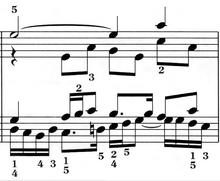
Back Melodie Afrikaans لحن (موسيقى) Arabic Melodía AST Мелодыя Byelorussian Мэлёдыя BE-X-OLD Мелодия Bulgarian স্বরমাধুর্য Bengali/Bangla Melodija BS Melodia Catalan ئاواز CKB

A melody (from Greek μελῳδία (melōidía) 'singing, chanting'),[1] also tune, voice, or line, is a linear succession of musical tones that the listener perceives as a single entity. In its most literal sense, a melody is a combination of pitch and rhythm, while more figuratively, the term can include other musical elements such as tonal color. It is the foreground to the background accompaniment. A line or part need not be a foreground melody.
Melodies often consist of one or more musical phrases or motifs, and are usually repeated throughout a composition in various forms. Melodies may also be described by their melodic motion or the pitches or the intervals between pitches (predominantly conjunct or disjunct or with further restrictions), pitch range, tension and release, continuity and coherence, cadence, and shape.